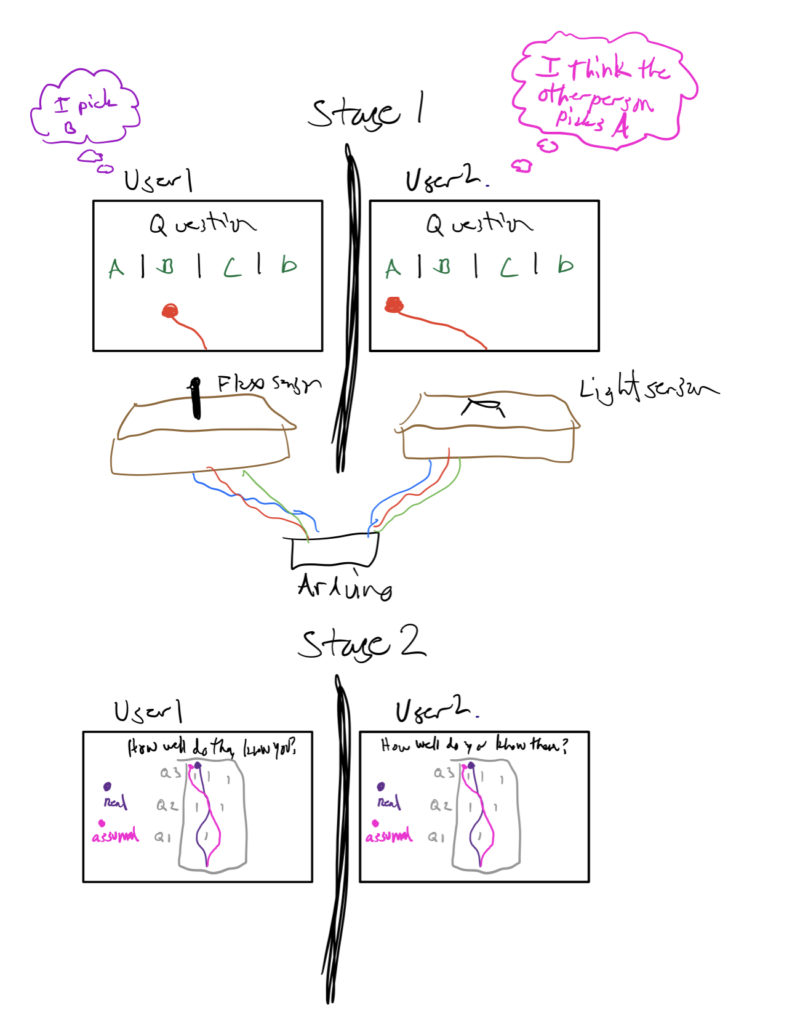For the project I wanted to play with this idea from an episode of a webcomic I read back in 2015 that’s sort of always stuck with me. The episode is “Pathway of a Person” from the series Color Drops, and it centers around the idea that when we talk to people and form relationships with them we get to new “levels” of understanding each other, starting with the first impressions, then on a casual basis, then to vulnerability, and finally to understanding each other as people and as friends.
In all honesty though, I’ve had a hard time melding this idea with interactive components, but this is what I have right now. Each player is drawing a path, and they are asked questions as they go. One person “leads” and just answers the questions as themselves, but the other person is trying to answer like the “leading” person. The questions start surface-level (dogs vs. cats, coffee vs. tea, etc), but get more in depth and complex as it goes (think myers-briggs questions and maybe more philosophical questions). The questions would be timed, and by the end, the paths are shown and compared and are asked “How well do you know them?” and “How well do they know you?”

As for the technical side, I want to play around with the flex sensors or the light sensor as the way users guide the paths. The path would be continuously drawn but move left and right based on inputs from the sensors.
Research I would need to do revolves around what questions to ask, and seeing if I could find a way to draw and save the paths digitally. I also need to find out if this would be (or even could be) done between two computers, or one at a time on one computer, because it would be nice to have the system automatically overlay the two completed paths, however a side-by-side comparison would be fine as well.
Artist Questions:
- Does the physical input make sense with the idea I had for the theme? Is there any disconnect?
- Any question suggestions? There are four “levels” I suppose; surface-level (yes/no & this or that), casual (some more in-depth this or that questions), vulnerability (Myers-Briggs personality quiz style questions), and real ones (the deeper questions. Thoughts on life, etc.). In all honesty I don’t know how I would do that last brand of questions in the style I’ve thus far been going for.
This is like the previous yes and no celebrity game show but with more options. This surely adds more fun to the game – but I am excited to try both of them out!
If the goal is to have your predicted path resemble your partner’s actual path as closely as possible, it may be helpful to have both players use the same kind of input device, be it a light sensor, flex sensor, or otherwise.
This may or may not address your second artist’s question about question ideas, but I think it would help the matching paths concept shine if the questions were degree-based. Similar to the Myers-Briggs test, questions would have something like a 1-5 scale on how much you agree with a statement.
I feel this way because if a player’s answer is A, and their partner guesses B, the visual would make them seem more accurate than if they had guessed D. Making the questions degree-based ensures that this representation reflects reality.
Very interesting concept you’re exploring! To piggyback off of Nathan’s post, using the Likert Scale would be a different way to answer questions. So:
(1) Strongly disagree; (2) Disagree; (3) Neither agree nor disagree; (4) Agree; (5) Strongly agree.
I do think that the overall concept is interesting and I see the correlation to why you choose the light and flex sensor. How would you incorporate the light sensor into the circuit design? In my opinion, on the technical side, I think using the slide potentiometer would allow for a more accurate way to choose the options, without having to rely on external factors like lighting.
In all honesty my original choice of sensors was because of the sensors I had access to, and even now I am not sure if I have a slide potentiometer I could use, but that is definitely something I will look into, as I agree that that motion is more connected to the kind the player would do.
I really like the idea! To answer the first question, I’m not sure about light sensor for input because I don’t know if the user will be able to get fine-tuned enough control with it to pick answers they want.
I believe either a flex sensor or potentiometer would make the most sense for controlling a path.
Very interesting concept – especially how one person will essentially try and follow another’s path. I notice the project reveal or surface-level judgments about each other, which is a really interesting effect, that could say alot.
To answer your question I think the input matches perfectly and should be simple and straightforward
Interesting concept! I’m excited to see it. I think that using the flex sensor would be best for scale answers, like from 1 to 10, and how the answers of A B C D may be more suited to a button system